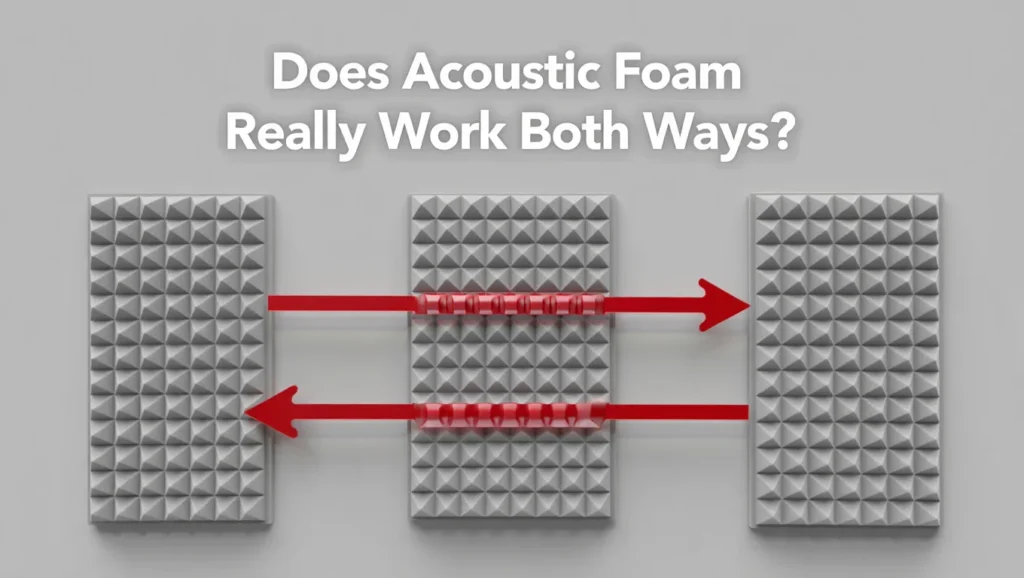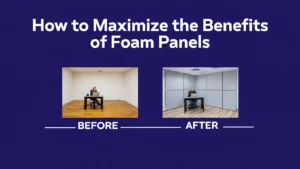Does Acoustic Foam Really Work Both Ways? — Tips for Maximum Sound Isolation

Not really, ordinary acoustic soundproofing foam does not facilitate a two-way soundproofing solution. Many individuals often confuse it with its dual features. That means it can block the external noise from transmitting inside a room and also contain the noise to prevent it from escaping the room. What most people miss to counter is the key distinction between sound absorption and soundproofing. Both terms impact the functioning of foam panels differently. If you have been disappointed with the results of soundproof foam, experiencing noise leak, you are not alone. This blog will address the confusion relating to “does soundproofing foam work both ways,” highlighting its usage and benefits towards sound isolation.
Two different problems: room acoustics vs sound isolation
People use the terms “soundproof” and “acoustic” interchangeably without understanding their distinct significance. These contribute to the rise in myths and shape expectations accordingly. Acoustic engineering separates its features into two distinct needs.
-
Acoustic treatment (absorption):
Caters to flutter, echoes and sound quality indoors. It uses sound absorption materials like bass traps, foam wedges and fabric panels. That breaks down reflected sound energy to control room resonance.
-
Soundproofing (isolation):
This prompts sound isolation that works by preventing the sound from escaping between spaces. For instance, minding the shared wall with the next apartment while playing drums. This would need you to seal gaps, decouple structures and add mass.
For inspiration, you might ask: what acoustic strategies help create balanced, multi-purpose rooms with effective noise control? Learn more in our multipurpose room acoustics guide.
The use of acoustic foam is more relevant for the first scenario. It bounces back the sound that has been absorbed inside a room. The echoes heard as a result of sound hitting the walls and other surfaces are handled by soundproof foams. It reduces those reflections and yields effective results for sound ranging from mid to high frequencies. Like that of a guitar, voices or cymbals. On the contrary, it does very little to block the sound from transmitting out. In simple terms, foam helps to hear inside, but does not stop what you hear outside.
Let’s Examine the Acoustics Behind the Question: Do Soundproof Panels Work Both Ways?
Soundproof panels are designed to prevent sound propagation from one room to the next. While some of them serve similar functions as foam and prioritize sound absorption. These are denser and heavier, built with materials like mineral wool, mass-loaded vinyl or even composite layers. These materials readily help with lowering sound transmission through walls. Unlike regular foam, which contributes to improving sound quality. The dense layered panels are equipped for both sound absorption and partial soundproofing.
If you are planning for maximum sound isolation, panels can serve the purpose better in combination with added mass, proper sealing, and structural decoupling.
Understanding the Science of Acoustic Foam
Acoustic foam is lightweight and porous; foam is not built with features to block sound waves physically. When a sound wave strikes a surface, the motion in air causes friction within the material’s pores. To measure the frequency, the noise reduction coefficient(NRC) is used. Higher reading translates to more absorption of sound across tested frequencies. However, you should not rely on its measurements to understand its soundproofing capabilities. Use metrics like sound transmission class (STC) for clearer results.
When your acoustic goals center on less cho, clearer mixes or vocal intelligibility in a studio or large space. Acoustic foam is your ideal partner. However, if you are aiming to keep your neighbours from eavesdropping effortlessly, foam alone won’t suffice for the cause.
Exploring the Physics Behind the Question: Does Soundproofing Foam Work Both Ways?
Unfortunately not. Most of these foams are built with sound absorption features. That won’t cater to blocking sound efficiently. It can help with sound reflections, echoes, and improve sound quality inside a room. Musicians can make use of a soulful practice session, and are equipped for home theatres too. It does not contain the mass that prompts the capability of blocking sound from leaving the room, passing through walls, floors, or ceilings.
It acts as a sponge for sound waves that intercept sound reflections to improve acoustic clarity. That means it will not keep your neighbours from getting interrupted during late-night drum practice.
How Some Panels Manage Two-Way Performance
Yes, but with qualifiers. Some products marketed as “acoustic panels” combine absorptive faces with a dense core or a heavy backing (for example, mineral wool panels backed with MDF, or panels that incorporate mass-loaded vinyl (MLV)). Those hybrid panels can contribute to both absorption (inside the room) and some transmission loss (between rooms). But the heavier, denser materials and careful construction are what provide actual blocking. Thin polyurethane wedge foam (the classic egg-crate look) will not be able to offer similar results.
So when someone asks, “Do soundproof panels work both ways?” The answer depends on the type of panel. With thin foam, the answer is no.
Why most DIY foam fixes feel ineffective for isolation
A few real-world reasons:
-
Low-frequency energy is sneaky
Bass wavelengths are long and need mass, decoupling, or tuned resonant solutions to reduce. Thin foam absorbs very little under ~250–300 Hz. That’s why you can still feel bass through walls even with panels everywhere.
-
Flanking paths dominate
Sound leaks through doors, windows, electrical outlets, ductwork, and even the building structure itself. If you don’t seal those, adding foam to a wall is like putting a sponge on a leaky bucket.
-
Orientation myths
Some sellers claim panels must face a certain way to “block” sound. Absorptive panels are typically symmetric in absorption performance. Blocking requires mass and proper placement in the construction, not the orientation of foam faces.
The Proven Path to True Sound Isolation
For isolation performance, follow a prioritized checklist. Each measure offers quantifiable improvement, and in combination, they significantly outperform foam.
- Seal the gaps first (doors, windows, penetrations). Start by closing up the air leaks. Install an acoustic sweep at the bottom of the door, gasket the perimeter, and caulk around the frames. These gap fixes deliver the most improvement for the least cost.
- Add mass to partitions. More mass means less transmission. Adding an extra layer of drywall (preferably with a damping compound like Green Glue between layers) increases STC significantly. Mass-loaded vinyl (MLV) is another practical option where you can’t add drywall.
- Decouple structures. Sound transmits mechanically through studs and joists. Methods like resilient channels, staggered studs, or floating floors interrupt that path. Decoupling is a construction-level solution, but among the most effective for low frequencies.
- Place absorbers to create a balanced room and tame low-frequency buildup. Thick absorbers built with mineral wool or fibreglass are positioned in corners to reduce unwanted frequency buildup. They make your place more balanced and sound clearer, accentuating details. However, they dont really block the sound completely from travelling to other spaces. To address low-frequency noise, you will need to include tuned resonant panels or Helmholtz traps in your soundproofing strategy.
- Treat doors and windows as weak links. Replace hollow doors with solid-core doors, add seals, or use double-pane windows or window plugs for serious cases.
- Address flanking: HVAC and cut-throughs. Ducts are notorious flanking paths. Use lined ductwork or create mufflers/sound attenuators designed for airflow and noise control.
- Measure and iterate. Use a decibel meter and simple tests (clap tests, music at a known volume) before and after upgrades. That tells you what’s working and where to spend next.
How to Maximize the Benefits of Foam Panels

Acoustic foam still belongs in your toolkit, just for the right job. Here’s how to use it effectively:
- Target reflections, not walls. Place foam panels at first reflection points (side walls, ceiling above listening position) to clean up imaging and clarity.
- Combine with absorptive cores. If you want panels that help both the room and modestly damp transmission, choose panels built around mineral wool or dense fibreglass rather than plain polyurethane foam. They have higher NRC and better low-frequency performance for their thickness.
- Use bass traps in corners. Low-frequency energy collects in corners. Thick traps or broadband corner absorbers yield big perceived improvements.
- Mounting matters. Float panels slightly off the wall or mount on frames. This increases effective absorption at low frequencies by allowing air flow behind the panel.
- Avoid relying on extra thickness. While it helps, especially for lows, practical gains come from correct material type and strategic placement more than just piling on thin foam.
Quick shopping rules (how to read product claims)
- If a product emphasizes NRC, it’s about absorption. That is good for echoes, not transmission.
- If a product lists STC or transmission loss curves (and shows heavy mass or a damped sandwich construction), it’s aimed at isolation.
- Beware of marketing blur. Many vendors use “soundproof” and “acoustic” synonymously. Check specs, and when in doubt, ask for lab-tested transmission loss charts.
Example scenarios — what to do
-
Home podcast studio:
Use absorptive panels at reflection points, bass traps in corners, and seal the door. If you can, mount panels on the wall with a thin air gap. Foam cleans up the sound in the room, not the sound leaving it. To keep your noise from reaching the neighbours, you will need heavier walls or a decoupled, isolated room structure.
-
Apartment neighbour noise (you want quiet):
-
Band rehearsal space:
Combine decoupling (floating floor or resilient mounts), mass on walls, and absorbers in key spots. Bass treatment and structural isolation are essential. Foam is cosmetic here unless you use thicker absorptive cores. Acoustical Surfaces
If you’ve ever asked how Canadian law enforcement facilities manage soundproofing for security and confidentiality, find detailed insight in our post on soundproofing for Canadian law enforcement
Want Acoustic help for your specific room? Jad Soundproofing is here.
At JAD Soundproofing, we design solutions around how your space actually sounds and feels. Our specialists sit down with you to pinpoint where the noise is coming from, understand your building type, and factor in all the little details that affect results. After assessing each, they help with a cost-effective list of upgrades. Our installation strategies are aimed at balancing clarity, comfort and isolation suited to your target space.
You can expect decibel reductions following physics and practical experience. Be it managing sound in your home, studio, or office, our acoustic services can help you understand the difference in sound clarity. Contact us today to install the right soundproofing for a quieter and cleaner audio experience.
Recent Posts
- The Importance of Sound Testing for Better Acoustics
- Does Acoustic Foam Really Work Both Ways? — Tips for Maximum Sound Isolation
- Multipurpose Room Acoustics Guide
- Designing Acoustics for Community Centers and Event Halls: A Complete Guide
- Keeping It Quiet: Why Soundproofing Matters in Canadian Law Enforcement